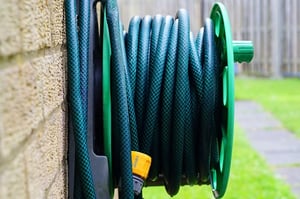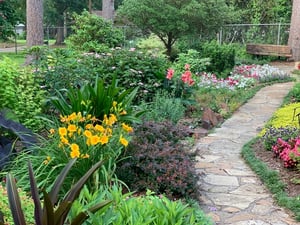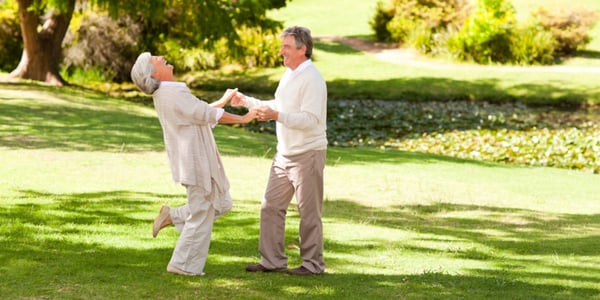Do you enjoy preserving memories? If so, scrapbooking may be the hobby for you! Scrapbooking is a...
How to Make Your Outdoor Space Safe and Age-Friendly
Slip, trip, and fall hazards are things to think of at all ages. With small children, we spend lots of time 'baby-proofing the house and making sure that floors are picked up. So why don't we spend the same kind of time managing and maintaining our adult spaces?
Much of this is because we become 'experts' at designing our spaces in such a way that we don't have a lot of hazards to avoid. We know where things are. The problem with this mentality is that we really don't. As adults, we're tough enough that bumping into things a little bit, stubbing our toes, or any number of smaller bruises collected throughout the day is no big deal. However, for small children, these things can be potentially lethal, not to mention injury-prone.
The harsh reality is that we all make mistakes and have accidents. The older we get, the more those accidents can be hazardous. A simple bump on the shin in your 20s may leave a bruise, but as we get on in years, those bruises become more colorful and can turn into more painful injuries. Getting rid of the coffee table and buying more plush sofas is an easy way to address this issue in the living room. Other indoor spaces can be kept free of slip, trip, or fall hazards more easily than something like your outdoor space.
Taking time out in nature is a wonderful way to relax and reconnect with the things we love. Therefore, a comfortable and safe outdoor space is a must. Unfortunately, our outdoor spaces are the hardest to manage due to the exposure to the elements and the propensity for things to move around outside. Maybe you had the family over for a barbecue, or you were entertaining friends and enjoying a cool evening. Either way, the patio furniture is often not exactly where you remember it. As fall comes, so too do leaves begin coating your deck. For these reasons, we've put together a few reminders on what to look out for to help avoid these extra dangers.
10 Age-Friendly Tips for Your Outdoor Space!
-
Is Everything in Its Proper Place?
To keep everything in its proper place, you need somewhere for it to go. With that in mind, our first tip is simply to construct or purchase storage spaces for your outdoor items. Whether this means buying a box for the seating cushions or hanging hooks for things like extension cords, it is always a good idea to plan for these necessities. Remember, sheds are great places to store things, but they shouldn't be too far from the house, and they require maintenance of their own. Once everything has a designated place to be stored, practice keeping them there when not in use.
-
Roll Up Your Hoses
 Hoses are typically not an issue on the patio or deck area. Instead, they are an issue in the yard. The fewer things to navigate in the yard on your way to your seating area, the better. Especially when entertaining, our attention may waiver, and we forget to pay attention to our footing. Hoses are particularly tricky because they may be hidden in the grass, and you might not have the choice to put them away right away if you are using them for tasks such as watering the lawn. However, rolling up hoses after use or doing anything else in the yard is an easy way to make things a bit safer in your outdoor area.
Hoses are typically not an issue on the patio or deck area. Instead, they are an issue in the yard. The fewer things to navigate in the yard on your way to your seating area, the better. Especially when entertaining, our attention may waiver, and we forget to pay attention to our footing. Hoses are particularly tricky because they may be hidden in the grass, and you might not have the choice to put them away right away if you are using them for tasks such as watering the lawn. However, rolling up hoses after use or doing anything else in the yard is an easy way to make things a bit safer in your outdoor area. -
Managing Extension Cords
Much like hoses, extension cords are an awful tripping hazard that crosses our paths all the time out on the patio. Cords may be stretched across the yard from previous use, perhaps from blowing leaves, and we forget about them. The best advice there is to simply collect your cords when you finish a project. But what about the cords that we have for more long-term use, such as cords for lighting, oscillating fans in the summer, or space heaters in the winter? These cords most likely will not be picked up often. The advice here is to find a spot where fans and heaters are most effective. Run your cord to that spot, and then cover the cord with a rug or a rubberized cord cover. This will nearly eliminate the trip hazard and cover up any unsightly cords. For lighting, consider stapling or otherwise tacking the cord to the wall or a fence.
-
Proper Lighting
 For most of us, light sensitivity becomes an issue rather quickly in life. Our eyes simply don't change as quickly as they once did. While having shade is incredibly important, it is worth considering whether your shade lets in light. You don't want to be baked by the sun, but having enough light to see well when coming under the cover is also a positive.
For most of us, light sensitivity becomes an issue rather quickly in life. Our eyes simply don't change as quickly as they once did. While having shade is incredibly important, it is worth considering whether your shade lets in light. You don't want to be baked by the sun, but having enough light to see well when coming under the cover is also a positive.
Likewise, lighting is incredibly important in the evening and at night or any other time when there is low visibility. While strand lights are cute, one strand may not provide adequate light. Many big box stores sell elegant lighting fixtures that use LED bulbs and provide sufficient light for a modest sum. You may also consider affixing lights to any poles nearby that could shine light on the entire patio or yard. Whichever configuration you choose, be sure that it provides enough light that there are no significant shadows. This will allow you to enjoy your space at any time while significantly reducing the risk of falling and injury. -
Plenty of Shade
A lifetime in the sun can leave one's skin vulnerable to its harsh UV rays. On days when the heat feels like an oppressive force, it is no more oppressive than in the direct sunlight. Therefore, making sure that your patio has sufficient shade is imperative. As we get older, the heat becomes increasingly more dangerous, and the threat of skin cancer is one that our bodies are less able to cope with.
As previously mentioned in our tip about lighting, shade is important, but it is also worth considering whether your shade affects visibility. If you've ever stepped into someone's covered porch on a sunny day and had trouble with your eyes not adjusting quickly enough, then you know what I mean. This kind of thing may occur because your shade is too low to the ground or you are tucked into a corner. Consider putting your awning or shade in a position where light can penetrate on at least three sides. Trees are also a great way to provide shade on a hot day. However, we must remember that trees drop leaves, and leaves present a trip, slip, or fall scenario. If there is a good shade tree near your patio, that's okay. Just consider building some type of angled covering that will allow leaves to slide or otherwise blow off it while also minimizing the number of leaves that drop into your patio area.
-
Building a Smooth, Level Walkway
 You'll want to ensure that your yard features a path to it that is free of debris, smooth, and level. While pathway stones may be more aesthetically pleasing than a straight concrete path, they have a greater tendency to shift and require more careful stepping. Consider having a concrete walkway poured (or doing it yourself). If you want to stay true to your paving stone aesthetic, pour the concrete around them, making them a permanent fixture. This will add character to the walkway and stability for your feet. It is worth noting that whatever surface you choose, take time to assess its grip potential in many different weather conditions. There's nothing more dangerous than a slippery path. The straighter this path is, not only will this make it shorter and cheaper to build, but it will also be more surefooted for you as you age.
You'll want to ensure that your yard features a path to it that is free of debris, smooth, and level. While pathway stones may be more aesthetically pleasing than a straight concrete path, they have a greater tendency to shift and require more careful stepping. Consider having a concrete walkway poured (or doing it yourself). If you want to stay true to your paving stone aesthetic, pour the concrete around them, making them a permanent fixture. This will add character to the walkway and stability for your feet. It is worth noting that whatever surface you choose, take time to assess its grip potential in many different weather conditions. There's nothing more dangerous than a slippery path. The straighter this path is, not only will this make it shorter and cheaper to build, but it will also be more surefooted for you as you age. -
Shaping the Grade
For many of us, navigating stairs can become increasingly challenging as we age. With this in mind, when designing your path to and from your patio, it is worth considering adding a ramp or even shorter, more gradual stairs that are easier to navigate. My personal recommendation would be the ramp. While this may seem like overkill, I assure you that there are many different reasons why a ramp can increase the joy in your life. Whether your knees are feeling extraordinarily stiff one morning or your grandkids have just discovered the joys of rolling things downhill, ramps are incredibly useful.
-
Give Yourself Options
The hammock is super comfy for naps, but it can also be difficult to get in and out of. On days when you're not quite feeling up to the hammock, of which there are plenty, having another reclining seating option is nice. Consider purchasing a comfy outdoor ottoman that doubles as a cushion storage box. You can move from chair to chair based on preference, and it doubles as extra seating when you have company. A small sofa may also be a good consideration. I've always been partial to rocking chairs and porch swings myself. Still, as we age, we must consider many factors when choosing a seat: height, depth, stability, and comfort. If you can't get into or out of your seat, it immediately loses much of its value.
-
Guage Your Abilities
Much like tip number one, this tip is just a reminder that none of these other tips work if you are unable/unwilling to maintain your patio space. With this comes the need to be judicious in determining what will and will not become part of your patio. Can you lift those cushions with ease? How about ten of them? Can you sweep the entire space, or will you be more willing to use a leaf blower? If you decide to hang any outdoor lighting, can you reach the bulbs in order to change them, or should you invest in LED bulbs that do not need to be changed as often, if ever? Considering your willingness and honestly gauging it with your future ability to maintain the space is incredibly important. Not that having a project/hobby is bad, but make sure it's one you actually want.
-
Consider a Different Lawn
Our final tip for patio safety is more of a suggestion on lawn care. As we age, heat and exhaustion become significant risk factors. Yard work and lawn maintenance have the potential to take their toll on us. "I love working in the garden," you say, and that is just fine. Keep your flowerbeds and your vegetable gardens; however, you may consider trading your grass for turf. We know! Turf is not the best looking, but they've done a lot with turf these days, making it more closely resemble the real thing. There are many reasons not to like turf as an option. Hear me out, though; turf does not require water to look good, and this also means that the plants you actually care about are not fighting for sometimes precious little water in the dry months.
Having lawns is, historically, a relatively recent cultural practice as well. This is because, in the past, only the rich could afford to maintain grass. It was a sign of wealth and decadence. Watering your lawn is the first thing that goes when water cuts are made during a drought or dry season. While putting in turf may be an initial expense, it has considerable potential to save you money and effort in the future while improving the safety of your yard.
Thanks for reading. We hope that employing just one of these strategies in maintaining your patio space will help to keep you and your loved ones safe. Getting older is not always fun, but retirement should be. Taking the time to ensure that your patio space is not only gorgeous but safe will improve your overall quality of life.






